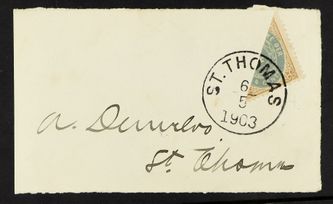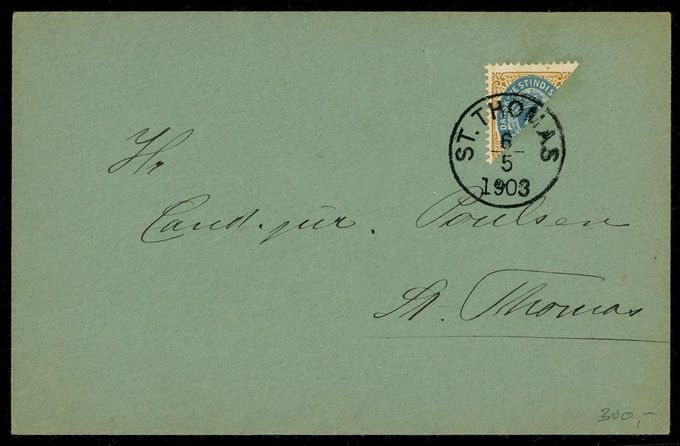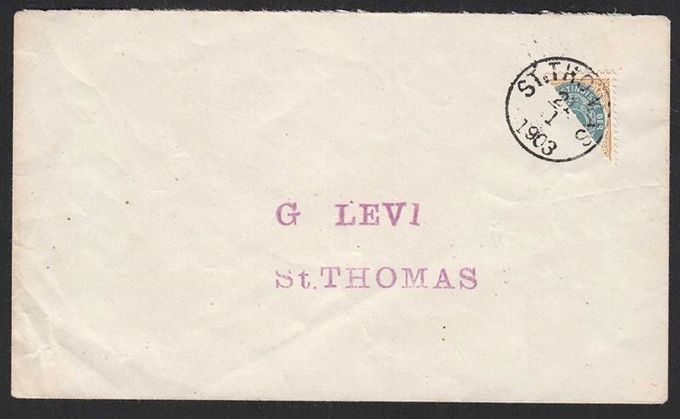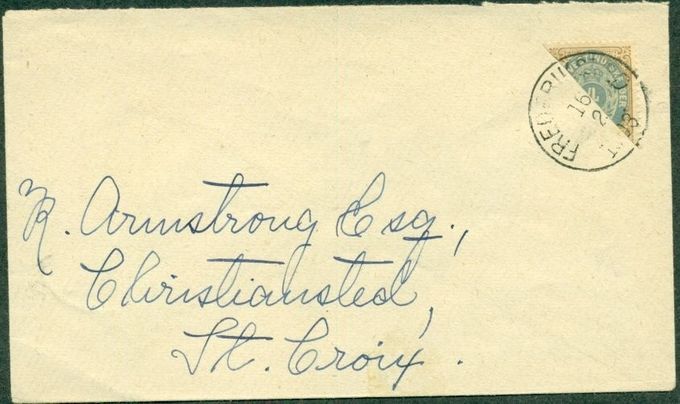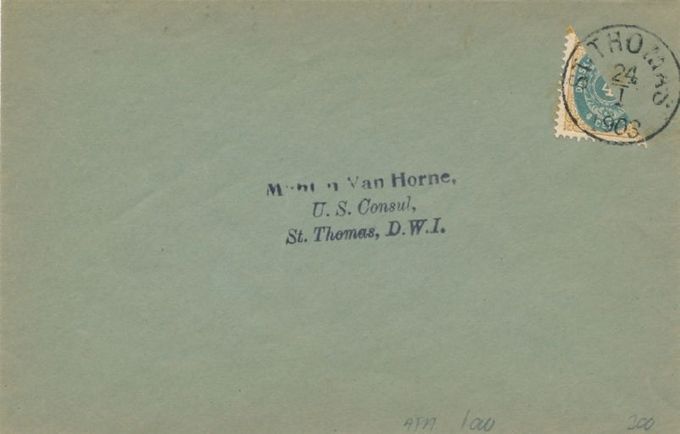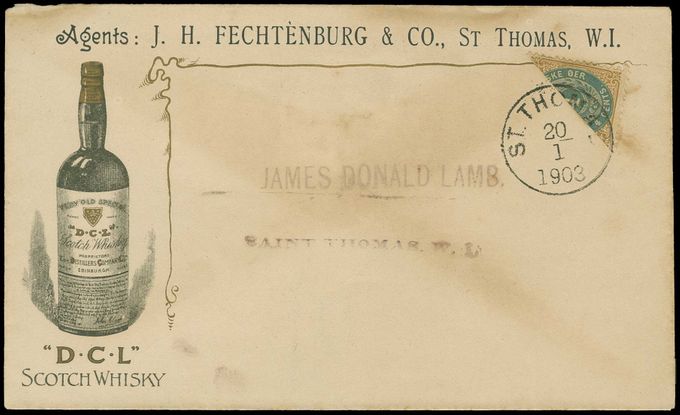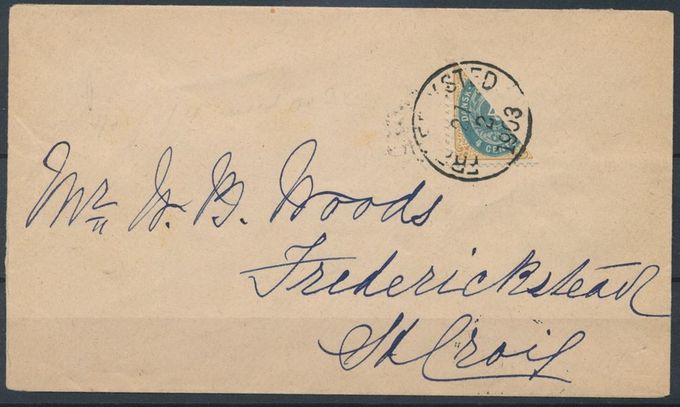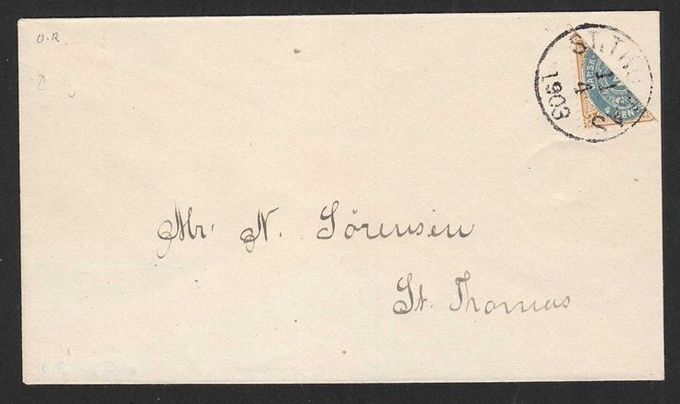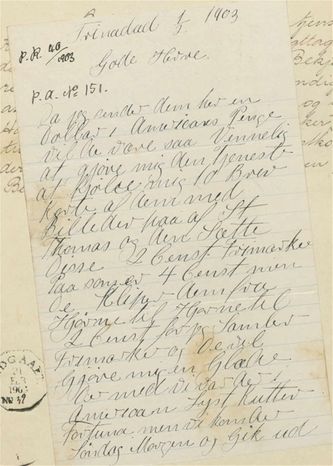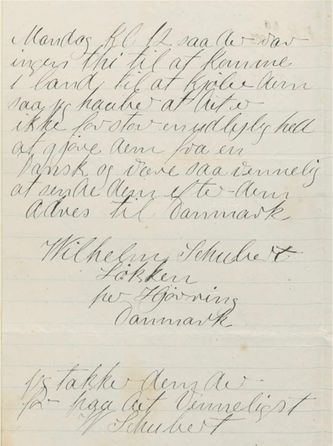CHARACTERISTICS OF GENUINE AND PHILATELIC USAGE
Mr. Arturo Duurloo was a philatelist sending a number of these tiny covers containing 4 cents of Printing 2. All cancelled St. Thomas May 6.
The aim of this page is to celebrate the philatelic influence on the mail load during the bisected era (January 20 - June 4 1903) and to provide inspiration for the collectors on how to embrace these more or less mass produced items.
It is not hard to imagine the philatelic interest caused by the authorization of bisecting 4 cents stamps in 1903. Anyone with just the slightest philatelic interest must have wanted such one. It is often mentioned that a cover is less valuable when proven philatelic. On this webpage I have also mentioned numerous times whether a certain cover is philatelic or not. I used to think of philatelic mail as less important and less authentic - as the main purpose of the philatelic mail was to generate value and interest rather than having a genuine postal purpose. I must admit that I still find that true to some extend - but I have now come to realize - just how many possibilities philatelic mail provides for us collectors - thanks to the amount of "extra" mail available for our collections.
Please note that in often cases it is very hard to truly tell whether a certain cover is philatelic or not.
BUT when the philatelist asks the Postmaster to send postcards to Denmark with bisected 4 cents it is not difficult to establish a motive (see bottom of this page).
CHARACTERISTICS THAT COULD INDICATE THE MAIL BEING PHILATELIC:
- when the envelope is sealed - mailed and not cut open.
- if multible items are sent to the same receiver from the same Post Office on the same day
- self-addressed mail
- covers lacking a receiver
- first day of use
- deliberate use of the scarcer and more valuable Printing 2 of the bisected 4 cents
- deliberate use of oval flaws (can be hard to tell whether it was deliberate. See photo below)
- deliberate use of multible bisected stamps on the same cover
- postcard sent without a message
- odd placement of the bisected stamp
- perfect placement of the bisected stamp (in combination with a beautifully written address - but can be hard to tell from genuine usage (Cut open strongly indicates genuine usage) Also see photo below.
- the cancel with the appearance of having been cleaned for the purpose of producing a beautiful cancel (would likely require collaborated action with the Post Office clerk - Mr. A. Duurloo covers could be an example of such practice). Also see photo below.
- mail sent in the first weeks of authorized bisected use on the different Islands.
Nicely positioned bisect - clean well placed cancel - nice hand writing - and the bisected 4 cents with the oval flaw "Upper oval line scratched above TIN". Cancelled St. Thomas May 6 1903. Rather late usage though.
Philatelic?
Note that the inverted frame was discovered in 1917 and therefore not used deliberately for philatelic purposes.
HOW AND WHAT TO COLLECT(?)
- AS A COLLECTOR YOU CAN USE THE BIG LOAD OF PHILATELIC MAIL TO SEARCH FOR:
- covers or partials with the 4 possible diagonal bisected stamp products and perhaps of same dates
- collecting cancels from the different Post Offices
- collecting cancels with specific dates - i.e. St. Thomas January 20-31 - where the philatelic awareness was at its highest (46% of all mail sent with a bisect from St. Thomas was cancelled on the first 5 days of use)
- collecting multible covers with identical receiver
- collecting mail sent to people with important or interesting titles and functions - i.e. policeman, manager of a bank, captain of a boat etc.
- collecting covers sent to well known places - i.e. Grand Hotel, Police Station, Banks, Estates, Drugstore, Telegraph building etc. perhaps in combination with postcards depicting the specific buildings.
BELOW IS A LIST OF RECEIVERS OFTEN ASSOCIATED WITH PHILATELIC MASS MAILING
G. Levi - using this characteristic reddish stamping.
Armstrong was a well known receiver of many covers sent from Frederiksted and often using Printing 2. Likely to be self-addressed.
Van Horne - U.S. Consul. Characteristic greenish envelopes and no hand writing.
Numerous January 20- first day of use postcards to Mr. James Donald Lamb. exist with this motif.
Woods has received numerous bisected covers - all cancelled Frederiksted and likely to be self-addressed.
Numerous covers exist with the Sörensen family as receivers. Always hand written.
A PHILATELIST ASKING THE ST. THOMAS POSTMASTER TO SEND SEVERAL BISECTED 4 CENTS POSTCARDS TO DENMARK
In Danish: (English translation coming soon)
Trinidad February 1 1903
"Gode Herre, Da jeg sender dem her 1 dollar i Amaricans penge vil de være så vennelig at gjøre mig den tjeneste at kjøbe mig 10 brevkort af dem med billeder paa af St. Thomas og den sætte disse 2 cents frimærker paa som er 4 cents men de klipper dem fra hjørne til hjørne til 2 cents for jeg samler frimærker og de vil gjøre mig en glæde. Der med vi var der i American lyst kutter Fortuna men vi kom der søndag morgen og gik ud....
...mandag kl 12 saa der var ingen thi til at komme i land til at kjøbe dem så jeg haaber at det er ikke for stor en udlejlighed at gjøre dem fra en dansk og være saa vennelig at sende dem efter dem andres til Danmark.
Wilhelm Schubert
Løkken
Her Hjørring
Danmark
Jeg takker dem der for paa det venneligst, W. Schubert"
Del siden
